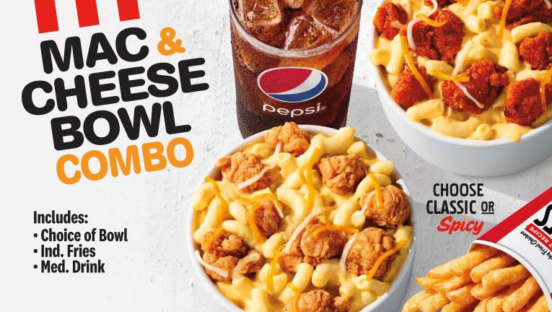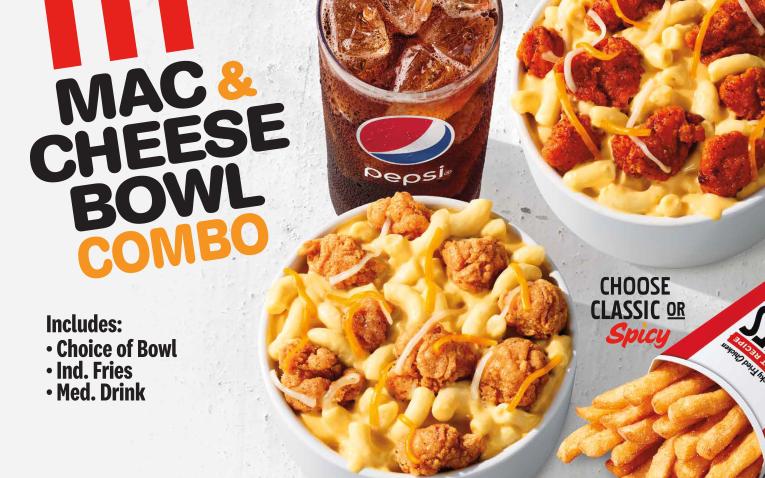Amid inflation and talks of a looming recession, Yum! Brands CEO David Gibbs isn’t noticing any concern from consumers—that’s the short answer.
Digging a little deeper, the executive has seen a K-shaped recovery among his restaurants, in which higher-income customers are showcasing more demand. Identifying this trend, Yum! implemented a barbell menu strategy to attract guests in the third quarter. For Taco Bell, Gibbs pointed to the $6.49 Double Steak Grilled Cheese Burrito, a premium-priced entrée, and the chain’s Cravings Value Menu, which includes $2 burritos. At KFC, restaurants used $5 Mac and Cheese Bowls to retain the low-income, value conscious consumer, as well as the $6 Drum and Thigh Combo. Pizza Hut attracted value customers with the return of the Big Dinner Box and a $6.99 medium one topping pizza deal when two or more are purchased.
The results speak for themselves. Taco Bell U.S. led the way with 7 percent same-store sales, boosted by the return of the Mexican Pizza on September 15. In fact, weekly traffic grew 6.1 percent when the item came back, compared to a negative 7.9 percent drop during the previos week.
KFC’s domestic comps grew 2 percent in Q3—fueled by the Mac and Cheese Bowls—after a 7 percent decline in the second quarter. Additionally, the Drum and Thigh Combo resulted in a “meaningful sequential improvement in transactions,” Gibbs said. Pizza Hut’s same-store sales increased 1 percent, a big improvement from the 4 percent drop in the previous quarter. In addition to value innovation, Gibbs attributed Pizza Hut’s growth to strength around third-party delivery. The gap between carryout and delivery was 23 percentage points in Q2, but that slimmed to 17 points in the third quarter. The Habit Burger Grill saw comps improve sequentially from Q2 on a three-year basis, with app downloads increasing 10 percent quarter-over-quarter. Digital now mixes 33 percent at the burger chain.
Gibbs said Yum!’s restaurants are particularly well-suited to navigate the upcoming economic environment because of its scale, purchasing ability, appeal, and the fact that 80 percent of its business is Taco Bell U.S. and KFC international, the latter of which saw 8 percent same-store sales growth in Q3.
“Now I know in other industries, like in other parts of retail, if you bought some furniture a couple of years ago, you probably pulled your demand forward—they’re not going to have the same demand today,” Gibbs told investors during the company’s Q3 earnings call. “We don’t have that issue in our industry because if you bought lunch two years ago, that’s not influencing your decision today. And your decision today is more determined by how we stack up versus your options. We know that we’re a really attractive option versus grocery, which is experiencing a lot of inflation. So this is a good environment for us.”
READ MORE: Yum! is ‘Scanning Categories’ for a Potential Acquisition
To the CEO’s point, particularly about grocery, restaurant menu prices rose 8.5 percent in September year-over-year, including 7.1 percent for quick service. Meanwhile, grocery prices soared 13 percent. Cereals and bakery products increased 16.2 percent and dairy and related products grew 15.9 percent. Remaining food groups saw rises ranging from 9 percent (meats, poultry, fish, and eggs) to 15.7 percent (other food at home).
Gibbs acknowledged that value is more of a factor today, but he views it as a return to normalcy rather than an exaggeration.
“There is a little bit more of an emphasis on this premium value, which is good for the industry, where products that aren’t at the absolute lowest price can still be very appealing to consumers as long as the overall equation, the experience, the convenience, the craveability of the food is all there,” Gibbs said.
The upcoming economic situation doesn’t appear to be impacting development either. Gibbs said numbers were “impressive,” and noted that figures aren’t too far off last year’s record pace. In Q3, Yum! opened a net of 644 stores. Last year, the company opened 760 net new units, a quarterly record. The CEO emphasized his confidence in growth, even with the loss of more than 1,000 KFC and Pizza Hut locations in Russia.
KFC ended Q3 with 26,872 restaurants, including 3,940 in the U.S. and 22,932 internationally. Pizza Hut had 18,807 stores globally, inclusive of 6,550 in the U.S. and 12,257 internationally. At Taco Bell, there were 7,974 stores, or 7,074 in the U.S. and 900 internationally. The Habit Burger had 341 units, with 329 being domestic.
CFO Chris Turner echoed Gibbs’ point, saying restaurants are still highly attractive investments for franchisees.
“Keep in mind that our franchisees on average compared to many other systems are larger, more sophisticated, more well-capitalized and more growth-minded,” Turner said. “They’re able to look through near-term noise in the market and actually take advantage of these types of disruptions in the marketplace to accelerate their growth. And so we’re very pleased with the state of our franchisee base and our partnership with our franchisees, plus we have the strongest development team in the business. So we’re working with them to navigate through that, but we feel good. In terms of cost of capital for our balance sheet, our balance sheet at Yum! remained strong and very resilient. I think we proved that as we navigated the last few years. We’re proud of the cash that we return to our shareholders.”
Global system sales increased 7 percent in Q3, led by Taco Bell (9 percent), KFC (8 percent), and Pizza Hut (4 percent). Core operating profit was 8 percent, fueled by 11 percent growth at Taco Bell and 7 percent growth at KFC, but a drop of 3 percent at Pizza Hut. Yum! earned $6 billion in digital sales, with the mix exceeding 40 percent.












